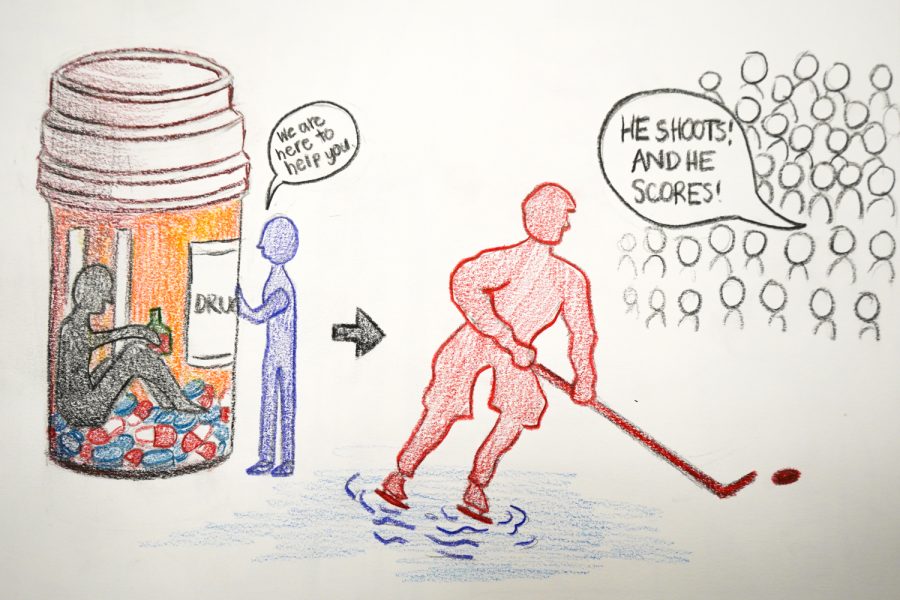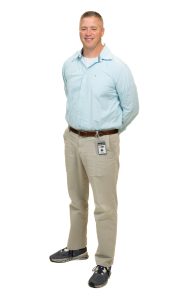All the Difference
Resources to battle addiction cannot be reserved for the lucky few who have the money and circumstances to access them.
An NHL player’s triumph over addiction is proof of the difference proper assistance can make.
March 10, 2020
Last week, I was mindlessly scrolling through Twitter when I came across a story that physically made my heart ache. I stopped in my tracks as I watched a video of Bobby Ryan, a professional hockey player for the Ottawa Senators, start to nearly cry on the bench. He had just scored a hat trick in his first game since completing the NHL Players’ Association assistance program for alcohol addiction. He had been sober for about 100 days.
I didn’t expect a thirty-second video to make me so emotional. I previously had no idea who Ryan was, and I’m not a Senators fan by any means. But as the crowd chanted his name and his teammates banged their sticks on the boards in solidarity and Ryan’s eyes filled with tears, I felt indescribably proud of this hockey player I didn’t know anything about.
I also felt a sense of intense sadness, because while it was incredible that Ryan had the courage to reach out for help and that he received it, this isn’t the case for most Americans.
In fact, only 10% of people who struggle with drug or alcohol addiction actually seek treatment. Oftentimes, a person may not be ready to admit how bad their problem is or feel too ashamed to reach out for help. But while stigma is certainly a factor, finances prove to have an even more of a crippling impact. 39% of addicts say they haven’t sought help because they know they cannot afford it or they do not have health insurance.
And when nearly 23 million Americans have some type of addiction, that statistic is frightening.
Without healthcare, or with a lacking plan, outpatient detox costs around $1,000, while inpatient rehab can range in price anywhere from $6,000 to $20,000 for a 30-day program. Not to mention, if someone requires medication to recover from their drug or alcohol addiction and manage withdrawal symptoms, it can cost an additional several thousand dollars a year. A recovering heroin addict’s medication costs an average of $4,700 annually.
This is especially problematic because, while poverty is certainly not a cause of addiction, people in lower-income areas are more prone to experience its risk factors. They are more likely to suffer from depression, which can lead to substance abuse. A lack of education also increases a person’s chance of becoming an addict, so areas with underprivileged schools are at a disadvantage. People in these situations can very rarely afford to pay for hefty prices of rehab.
It’s clear that there are many issues with America’s healthcare system, and there are many other ailments that require more support and funding than they currently receive. But addiction is primarily overlooked because it can be easy to place the blame on the addict and act as if drinking or doing drugs is their choice.
In reality, addiction actually changes a person’s brain chemistry and neural paths. When someone does something that could be potentially addictive, their cerebral cortex releases the neurotransmitter dopamine. The speed and intensity with which the dopamine is released can be directly related to how likely someone is to develop an addiction. To oversimplify a lot of complex theories, the dopamine can then interact with another neurotransmitter that impacts a person’s memory and learning processes. That’s why, over time, the brain’s neural system actively longs for the addictive behavior.
I’m not trying to make excuses for any addicts because I know how horrible addiction is. My whole life has been altered by it. My father was an alcoholic, and his addiction, combined with his mental illness, led to him taking his own life. I witnessed my dad trying to stop drinking countless times, and although I considered him to be the strongest person in the entire world, he just couldn’t.
That’s something most people don’t understand about addiction until they see it firsthand. Recovery is not about the addict’s willpower. It’s not about how badly they want to quit. My dad wanted to stop drinking and be a good father with everything he had in him, and it wasn’t enough.
Recovery revolves around science, rehabilitation centers, medication, and support groups. These are the resources we’re lacking. They are the things that many Americans cannot afford, even if they are offered.
Unfortunately, recovery also requires a little bit of luck. I’d be ignorant to suggest otherwise. My dad went to rehab several times. He received proper medical treatment—something I was always so thankful for because I was painfully aware of how rare it is— but, as I mentioned, he never fully recovered.
That was something I had to forgive him for. It’s hard to accept that something as innate as our own actions can be out of our control. Sometimes, all the right things can be in place, but because we’re all human beings it doesn’t work out.
It doesn’t mean we should stop trying. In fact, it means we should try harder. Even the most expensive and prestigious rehabilitation centers available aren’t guaranteed to cure someone’s addiction, so we need to keep developing techniques and ways to help those who are struggling.
I also look at this argument from a somewhat-selfish standpoint. A Harvard Medical School study found that 40% to 60% of susceptibility to addiction is hereditary. Additionally, over half of all American adults have a family history of alcohol problems, so genetics is likely to be a huge factor as addiction becomes a larger issue in our country.
Of course, genetics can only play a role after a person participates in an addictive behavior, so a person’s choice to drink or do drugs initially puts them at risk. But my paternal grandparents struggled with drinking. Several members of my father’s extended family have had gambling or alcohol addictions. It’s only logical to think that my dad’s family history impacted his condition.
I know millions of other kids have stories just like mine. Their experiences are often swept under the rug– hidden under shame and a desire to return to normalcy and pretend that nothing is wrong. So it’s never been more important to actively face addiction as a silent killer and do something to make their worlds a little less scary. They deserve to not be afraid anymore.
While I may have not expected Ryan’s story to hit so close to home, I understand why it did. An alcoholic beat his addiction in a way my dad was never able to do, and it gave me some kind of hope. I’m glad that a professional athlete is being outspoken about his struggle in an effort to end its stigma, and I’m happy to see someone else’s success story. It serves as a reminder of the power that proper treatment and support can hold.
But not everyone has a professional assistance association available at their fingertips. And, clearly, it can make all the difference in the world. The same resources must be distributed to the many, not simply reserved for the few who are lucky enough to access it.














Mrs M • Mar 10, 2020 at 9:52 pm
Kristen,
You are one of the strongest students I have ever encountered! I am so impressed with your maturity and the positive attitude you have toward all of the terrible things you have experienced watching your Dad suffer with an awful illness.
I’m certain he is very proud of you. I am proud of you too!
anonymous • Mar 10, 2020 at 7:00 pm
Hi, I m not sure if this would mean something or not, but I really like the articles you have been writing about recently and the subject matter you focus on, keep it up!